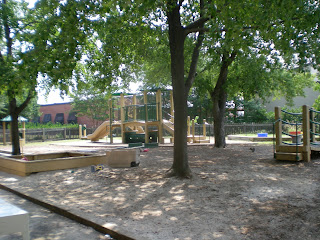I believe that architecture invokes happiness when it is aligned with the values of the the one who experiences or inhabits that space. In our reconnaissance walk I observed children at play at an on-campus day-care center. Because I value play and associate play with joy and happiness I would define the Curry Child Care Center as a happy place.
The children's playground at the Curry Child Care Center (photo: http://ccepp.uncg.edu/curryannex.htm)
Filled with laughing, happy children enjoying the sun, the sand, and actively taking part in games to me is happy. Though I shared this opinion with my classmates there were a couple who disagreed because their value of children and playgrounds did not align with my own. Perhaps this is the first "rule" for happy architecture - that it fits the values of the ones it intends to serve.
A children's playground is certainly less happy when not in use (photo: http://ccepp.uncg.edu/curryannex.htm)
In the absence of the intended population the playground as a place is less happy. Have we stumbled upon rule #2? A happy place is a utilized space; it is commodious. The purpose of the playground is straightforward: to entertain young people and provide for them physical activities that are beneficial to their physical and emotional health. And this could also be true for other happy places and spaces.
Since I am drawn to the outdoors the Sculpture Garden at Weatherspoon Museum on campus is a space that I also find happy. Like the playground it aligns with the values I hold, specifically for art, community, and nature. At times it fills the service of a quiet place to contemplate as well as an active and exciting place to meet others.
Happiness through connecting to the natural in the Weatherspoon Museum Sculpture Garden (photo: http://weatherspoon.uncg.edu/sculpturegarden/)
So, like the playground it is useful and serves a function. With respect to the other classically-defined rules of design I may have to take issue with requiring firmness. One thing that both the playground and the sculpture garden reflect is the dynamic and changing nature of our spaces. I find both beauty and happiness in the fluidity and impermanence of places and spaces. As a fickle human I require an element of change in my architecture - how boring life would be if nothing ever changed.
The changing exhibitions of the Sculpture Garden illustrates the beauty that can be through change and a total lack of firmness.
Exhibits at the Sculpture Garden change and are changed by the surrounding natural landscape (photo: http://weatherspoon.uncg.edu/sculpturegarden/)
De Botton says that "we speak of being 'moved' by a building, we allude to a bitter-sweet feeling of contrast between the noble qualities written into structure and the sadder wider reality within which we know them to exists" - but I would disagree. It is not the "sadder wider reality within which we know them" it is the beauty of the surrounding and ever-changing contexts that bring happiness. It is the anticipation of greater, more beautiful things that brings happiness to architecture. It is Vitruvius' delight - that unique ephemeral quality that is hard to define but that which most of us can point at it when we see it.
It is this alignment with our own values whether individually, as a class group, or as a greater culture that defines happiness in architecture. For some it is the value of leisure, physical activity, and play - for others it is creative expression through art and through an ever-maturing landscape.
Monday, February 28, 2011
Subscribe to:
Post Comments (Atom)




I really enjoyed reading this response :) I find it interesting and unique that you are happy when the people in the atmosphere are happy. I agree that things would be boring if nothing ever changed. I wonder if that is why people are drawn to the outdoors because it is constantly changing?
ReplyDelete